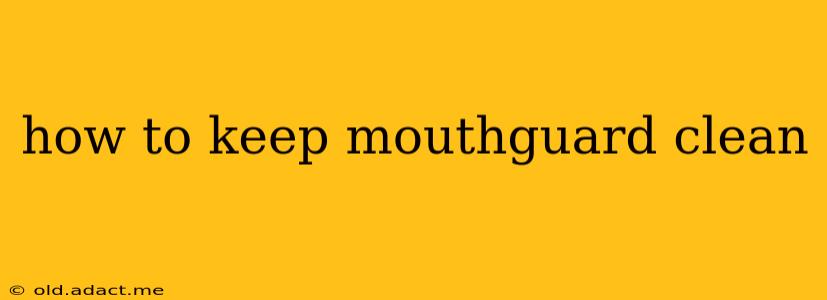Maintaining a clean mouthguard is crucial for both your oral hygiene and the longevity of the guard itself. A dirty mouthguard can harbor bacteria, leading to bad breath, gum disease, and even infections. This guide will walk you through the best practices for keeping your mouthguard sparkling clean.
How Often Should I Clean My Mouthguard?
You should clean your mouthguard after every use. This is non-negotiable for maintaining optimal oral health. Think of it like brushing your teeth – it's a daily ritual essential for preventing problems.
What's the Best Way to Clean a Mouthguard?
The cleaning method depends on the type of mouthguard you have. However, the core principles remain the same: rinse, brush, and soak.
Rinsing Your Mouthguard:
After each use, rinse your mouthguard thoroughly with cold water. Hot water can warp the material of some mouthguards. This initial rinse removes loose debris and saliva.
Brushing Your Mouthguard:
Use a soft-bristled toothbrush and a mild soap (like dish soap or a specialized mouthguard cleaner) to gently scrub all surfaces of the mouthguard. Pay special attention to any crevices or areas where debris tends to accumulate.
Soaking Your Mouthguard:
Soaking your mouthguard is a great way to deep clean it and kill bacteria. You can use a solution of water and mouthwash, or a specialized mouthguard cleaning tablet or solution. Follow the instructions on any commercial product you use. Soak for at least 30 minutes, but longer is better.
What About Special Cleaning Solutions?
While soap and water are effective, specialized mouthguard cleaning solutions can provide more thorough disinfection. These often contain ingredients designed to kill bacteria and remove stains. Look for solutions specifically designed for mouthguards, as other cleaning products might damage the material.
Are there natural ways to clean a mouthguard?
Yes, you can use a solution of baking soda and water to clean your mouthguard. Mix a small amount of baking soda with water to create a paste, then apply it to your mouthguard and gently scrub with a soft-bristled toothbrush. Rinse thoroughly afterward.
How to Store Your Mouthguard Properly
Proper storage is just as important as cleaning. Store your mouthguard in a clean, dry, and well-ventilated container away from extreme temperatures. This prevents the build-up of bacteria and keeps the mouthguard from getting damaged. Avoid storing it in a damp or enclosed space.
What if My Mouthguard Still Smells Bad?
Even with diligent cleaning, some mouthguards may retain odors. Try soaking it in a solution of white vinegar and water (equal parts) for a few hours. This can help neutralize odors and kill lingering bacteria. If the smell persists, consider replacing your mouthguard.
How Often Should I Replace My Mouthguard?
The lifespan of a mouthguard varies depending on its type and usage. However, it's generally recommended to replace your mouthguard every 6-12 months, or sooner if it shows significant wear and tear or develops persistent odors that you can't eliminate.
Can I Use a Toothbrush to Clean My Mouthguard?
Yes, a soft-bristled toothbrush is ideal for cleaning your mouthguard. Avoid using hard-bristled brushes, as these can damage the material.
What Happens if I Don't Clean My Mouthguard Regularly?
Failing to clean your mouthguard regularly can lead to a buildup of bacteria, resulting in bad breath, gum disease, and potentially more serious oral health problems. Additionally, a dirty mouthguard can become less comfortable and even prone to damage.
By following these simple steps, you can ensure your mouthguard stays clean, fresh, and effective in protecting your teeth and gums. Remember, consistent cleaning is key to maintaining optimal oral health and extending the life of your mouthguard.
